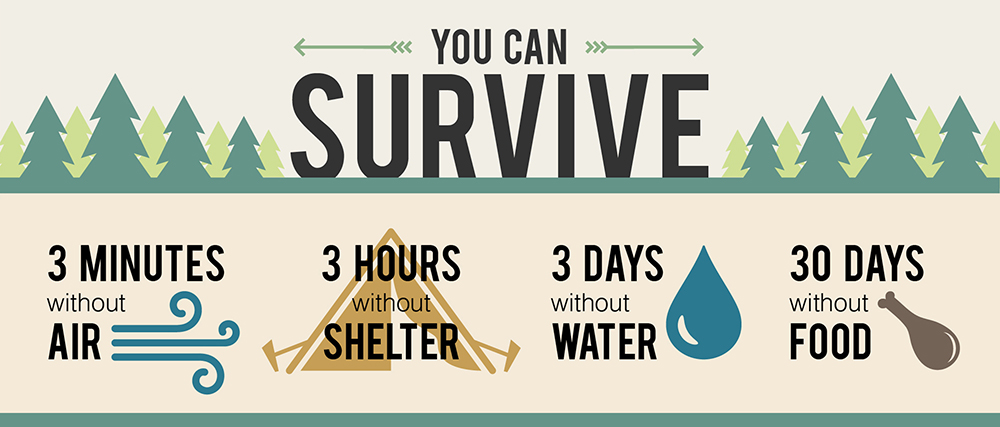

When venturing to risky or remote regions try to pack all of the essentials of survival into an Altoids can. The rule of 3 survival mnemonic is just a guideline know your limits.Here is a challenge for you on your next trip. Use common sense and act according to your unique circumstances and needs. Staying put and signalling for help or getting back to civilization are your main options. You should prioritize signalling for help and/or self-rescuing before having your ordeal turn into a starvation contest: if lack of food is a problem then you probably have spent more than two weeks without food and you are probably in deep trouble.

In hindsight following the valley downhill was the easiest and less risky way of finding help.īy all means ration your food, but keep in mind that your body will be consuming itself anyway. They decided against going downhill while planning their improvised expedition. For example the rugby team that crashed in the Andes survived 72 days and was rescued after two players climbed over the Andes mountains and found a farmer. If you’ve been marooned in a remote island with no prospects of being rescued in the next weeks or months then food is a priority, but for most scenarios food acquisition is not.Ĭonserve calories: do things the easiest and most efficient way. Very few short term survival situations require food. Our bodies are naturally prepared for short periods of starvation, that’s why they tend to accumulate fat. If you can’t melt snow with your body temperature, then eat snow as a last resort. Don’t eat snow (it will cool you down) if you can melt snow with fire and a sock. You want your body to perform, and being dehydrated hinders your ability to maintain your temperature. In sub-freezing temperatures, drinking water is just as important. If it is clear then you are well hydrated. To know if you’re adequately hydrated look at the color of your pee: it should resemble lemonade. Don’t exert yourself if you are dehydrated, and be aware that dehydration can prevent you from thinking clearly.

If the heat is extreme, rest during the day and consider night travel. Your need for water will vary a lot depending on how hot and humid the environment is and your activity levels. Stay away from water with obvious signs of toxicity like dead animals and no vegetation. It is best to treat suspect water, but drinking dirty water is better than dying of dehydration. Water is used by most processes of the human body, so naturally it is one of the most important needs. Signal fires, signal mirrors, whistles, flares and plbs should be used when appropriate. Try to find high ground to send an emergency text if there are cellphone towers nearby. You never know when the next opportunity to signal someone could present itself. Signalling is not as urgent as first aid or shelter, but you should be ready to signal for help as quickly as possible. That is why a survival kit should have various ways of starting a fire. Clothing and fire are effective ways of maintaining your body temperature. If needed, find or build a shelter to minimize heat loss or gain. The body looses and gains heat through radiation (sun, fire, body), convection (hot and cold wind), sweat (heat loss through evaporation), conduction (sleeping on snow), breathing (heat loss), and drinking (heat gain/loss). In extremely hot temperatures taking shelter from the sun is a priority. In extremely cold temperatures, and in wet and cold conditions taking shelter from the wind, precipitation and the ground is very important to keep your body at 98.6 degrees.
#What are the 3 rules of survival free
This free study guide is stuffed with the juicy details and. I highly recommend having wilderness first aid knowledge and training, but common sense can also help you discern between urgent issues and stable, minor issues. Find out what happens in our Chapter 3 summary for The Rules of Survival by Nancy Werlin.

Giving first aid to yourself or others to address A, B, C, D: Airway, Breathing, Circulation, or Deadly Bleeding should always be a priority as long as there is no other immediate danger like a fire. without food (some overweight people have fasted longer than a year).with cardiac arrest or heart stop (hypothermic people have survived longer than 6 hrs of CPR).without breathing (child survives 45min under water).in icy water ( Anna Bågenholm survived for 80 min).There are countless exceptions to every single rule the human mind and body can be extremely capable when pushed to the limits. That’s why I’ve taken the 3 out of the rule of threes to show a broader range of time for different people and situations. The first rule is that there are no rules, only rough guidelines.


 0 kommentar(er)
0 kommentar(er)
